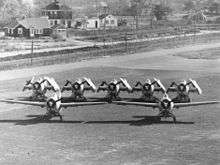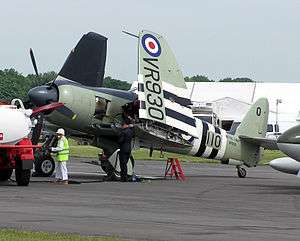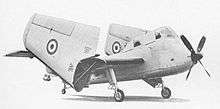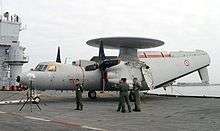Folding wing
A folding wing is a wing configuration design feature of aircraft to save space, and is typical of carrier-based aircraft that operate from the limited deck space of aircraft carriers. The folding allows the aircraft to occupy less space in a confined hangar because the folded wing normally rises over the fuselage decreasing the floor area of the aircraft. Vertical clearance is also limited in aircraft carrier hangar decks. In order to accommodate for this, some aircraft such as the Supermarine Seafire and Fairey Gannet have additional hinges to fold the wingtips downward, while others such as the S-3 Viking have folding tails.
Short Brothers, the world's first aircraft manufacturer, developed and patented[1] folding wing mechanisms for ship-borne aircraft (Short Folder), the first patent being granted in 1913. The wings were hinged so that they folded back horizontally alongside the fuselage,[2] usually being held in place by latches projecting sideways from the rear of the fuselage.
Since the monoplane supplanted the biplane in the late 1930s, virtually all fixed-wing aircraft designed for shipboard duty have been equipped with folding wings. Notable exceptions include the SBD Dauntless, F2A Buffalo, and A4D/A-4 Skyhawk (all USN types), the Mitsubishi A5M, and Yokosuka D4Y (Japanese), and the Sea Harrier (British). All six are relatively compact designs.
A folding wing has some disadvantages compared to a fixed wing. It is heavier and has more complex connections for electrical, fuel, aerodynamic and structural systems.

Many naval helicopters have rotor blades that can be aligned over the fuselage to save space on board ships.
Folding surfaces are rare among land-based designs, and are used on aircraft that are tall or too wide to fit inside service hangars. Examples include the Boeing B-50 Superfortress and its folding tail. The Saab 37 Viggen and the Boeing 377 Stratocruiser have foldable rear fins that make them lower for entering hangars. The Boeing 777 (classic) twinjet wide-body airliner was offered with folding wingtips for confined airports, and after the launch at Dubai Air Show, three Middle East airlines placed orders and commitments for nearly 600 airplanes from Boeing and Airbus. The new Boeing 777X set a record for the launch of a wide-body airplane with 224 orders and commitments alone from Abu Dhabi-based Etihad Airways, Dubai-based Emirates Airlines, and Qatar Airways.[3][4] Both Boeing 777X models will feature a shorter and simpler folding wingtip than was planned for the earlier Boeing 777. This will provide an extra 7 metres of wingspan in flight, yet the plane will still fit inside the same airport gates as the 777-300.
Gallery
Simple fold
 Short Folder S.64 being hoisted aboard the cruiser HMS Hermes (horizontal fold)
Short Folder S.64 being hoisted aboard the cruiser HMS Hermes (horizontal fold)
 Hawker Sea Hawk FGA.6
Hawker Sea Hawk FGA.6
 F-8H in an elevator
F-8H in an elevator RAF Buccaneer S.2
RAF Buccaneer S.2
Aftward fold
.jpg) Grumman F6F Hellcats of the US Navy. The patented Sto-Wing system was common to Grumman fighters of World War II.
Grumman F6F Hellcats of the US Navy. The patented Sto-Wing system was common to Grumman fighters of World War II.


Double fold
Rotating wing
 A V-22 Osprey with wings rotated to run the length of the fuselage
A V-22 Osprey with wings rotated to run the length of the fuselage
Folding-wing planes on flight deck
 FM-2 Wildcats on USS Kitkun Bay (1944)
FM-2 Wildcats on USS Kitkun Bay (1944) Avengers on USS Hornet (1945)
Avengers on USS Hornet (1945)_aerial_c1959.jpeg)

Notes
- ↑ Patents secured by Short Brothers including patents nos. 1792/13, 15727/13 and 28610/13, 5290/14, 20537/14 and 9276/15, see Barnes and James, pp. 92, 110
- ↑ Flight 1956
- ↑ Boeing Sees Record Orders for Its Slick Folding-Wing Airliner
- ↑ "Type Acceptance Report – Boeing 777" (PDF). Civil Aviation Authority of New Zealand. p. 3. Retrieved December 1, 2008.
Bibliography
- Barnes C.H. & James D.N. Shorts Aircraft since 1900. London (1989): Putnam. p. 560. ISBN 0-85177-819-4.
External links
| Wikimedia Commons has media related to Folding wings. |


